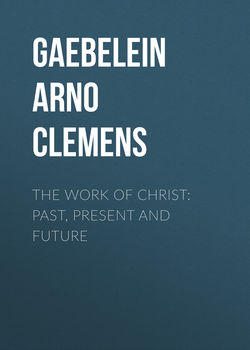Читать книгу The Work Of Christ: Past, Present and Future - Gaebelein Arno Clemens - Страница 4
THE WORK OF CHRIST
I.
HIS PAST WORK
Manifestations of Jehovah
ОглавлениеAnd the same Jehovah appeared in visible form unto Abraham. He came as traveller accompanied by two angels. He ate in the presence of Abraham, who worshipped and addressed Him as Lord. This Being was none other than the Son of God, the same who after His resurrection appeared to the two disciples on their way to Emmaus as a traveller, and who, at another occasion, ate of a honeycomb and a piece of fish. In His presence Abraham interceded. This Lord, who visited Abraham later, made fire and brimstone fall from heaven upon Sodom and Gomorrah; He executed judgment. He appeared unto Jacob and was the mysterious man who wrestled with him at Peniel; later Jacob called Him “The Angel, the Redeemer.” Repeatedly we hear of Him as “The Angel of the Lord,” not a created angel, but an uncreated Being. Moses saw Him in the burning bush, and heard His voice. And while He is spoken of as the angel of the Lord, He revealed Himself as Jehovah and made this Name known to Moses. He was with Israel in the wilderness and dwelled with them in the Glory cloud. He guided them, supplied their need, protected them, judged them and overthrew their enemies. To Joshua He appeared and manifested Himself as “The captain over the Lord’s hosts.” Manoah and his wife saw Him, and witnessed His ascension into heaven, in the smoke and fire of the sacrifice. Isaiah, Ezekiel and Daniel gazed upon His Glory. All these were but foreshadowings and glimpses of the two great manifestations of the Son of God on earth, as they are necessitated by His work, His manifestation in humiliation and His manifestation in power and glory.
Other Foreshadowings of His Work
But there are other foreshadowings of His work. All the divinely given institutions and many of the historical events recorded in the Old Testament foreshadow His work. History, as recorded in the Old Testament, is the preliminary history of the incarnation. The whole sacrificial system of the levitical priesthood told out beforehand, in many ways, what the great redemptive work of the Lamb of God was to be. Each offering and sacrifice revealed the different phases of His work on the cross, as well as His holy and spotless humanity. The sufferings of Christ and their meaning for lost sinners were thus made known. From Abel’s lamb to the last lamb, which died before the true Lamb of God uttered the never to be forgotten words on the cross, “It is finished,” the thousands of lambs and bulls and goats, the innumerable herds of animals slain, were all types of the one great sacrifice, brought on Calvary’s cross. The tabernacle in all its appointments, down to the minutest details, had I some meaning in connection with the Person of Him who is “Wonderful” and His wonderful work. And what else could we say of the historical events, such as the Passover, the passage through the Red Sea, the brazen serpent hung up in the wilderness. And to this we might add how men in their experiences, like Isaac, Joseph, David and others foreshadowed the sufferings of Christ and the glory that should follow.
Direct Prophecies
Still more numerous are the direct prophecies announcing the different phases of the work of Christ. That He should appear as man, how and where He should be born, His life, His service, His miracles, all was repeatedly foretold by the Prophets. But the great mass of predictions concern His sufferings as the sin-bearer and His glories as the King. None of the details of His sufferings were omitted. Think, for instance, of the predictions contained in the xxii Psalm. Death by crucifixion was unknown among the Jewish people. No nation in touch with Israel, living at that time, put human beings to death in that way. It was reserved for cruel Rome to invent death; by crucifixion. Yet in this Psalm there is given by divine inspiration a complete picture of that unknown mode of death by crucifixion. We read of His hands and feet pierced, the bones out of joint, the excessive thirst, the tongue cleaving to the jaws. And so we find His resurrection, His presence with God, His coming again and His Kingdom of Righteousness and Glory foretold in the Prophets.
The Inspiration of the Old Testament
We emphasize these facts of divine foreshadowing and prediction, because in these last days thousands of men have arisen throughout Christendom who boldly deny the inspiration of the Old Testament. They would have us believe that all these wonderful predictions are of human origin. They brand nearly everything as legend, and declare that there are no Messianic predictions in the Bible, that God did not speak to the Prophets concerning His Son and His work. Such a denial of the revelation of God in the Old Testament Scriptures is but the vanguard of the denial of the Son of God and His work. “Denying the Master that bought them” (2 Peter ii:1), is the leading phase of apostate Christendom in the last days. It is Anti-christianity. This denial is preceded by a denial of the written Word of God. The higher criticism, so called, is Satan’s leaven which leavens the theological institutions of Christendom and is fully preparing an empty Christian profession for the reception of the Man of Sin. To believe that these marvelous, harmonious predictions and fore-shadowings contained in the Old Testament are the productions of clever men, legends put together by evil men, who claimed to have received them from God, is far more difficult than to believe that they are given by divine revelation.
